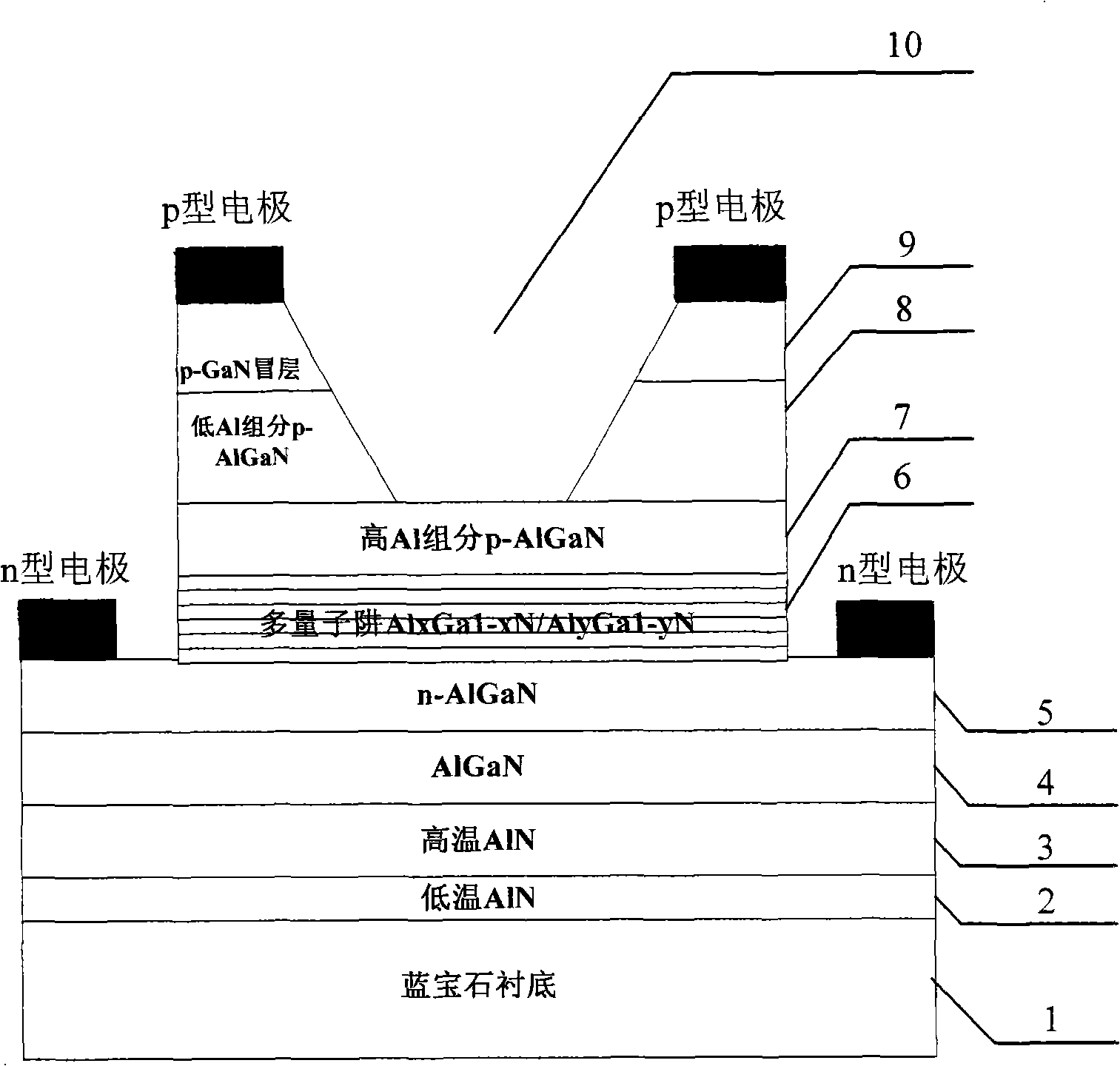AlGaN-based multiple quantum well uv-LED device based on sapphire substrate and manufacturing method
A sapphire substrate, quantum well technology, applied in semiconductor devices, electrical components, circuits, etc., can solve the problems of only 0.01% external quantum efficiency, large optical loss in the middle, and poor crystalline quality of the bottom AlN buffer layer, etc. Effects of optical power and external quantum efficiency, improving yield and reliability, and improving external quantum efficiency
- Summary
- Abstract
- Description
- Claims
- Application Information
AI Technical Summary
Problems solved by technology
Method used
Image
Examples
Embodiment 1
[0052] Embodiment 1, on the sapphire substrate, use ICP dry method and wet etching method to make a light exit window similar to a cone, the steps are as follows:
[0053] In step 1, a low-temperature AlN nucleation layer 2 is grown on a sapphire substrate 1 by MOCVD process.
[0054] The substrate temperature was lowered to 600°C, the growth pressure was maintained at 50Torr, the flow rate of hydrogen gas was 1500 sccm, the flow rate of ammonia gas was 1500 sccm, and the aluminum source with a flow rate of 28 μmol / min was introduced into the reaction chamber to grow a low-temperature AlN nucleation layer with a thickness of 10 nm.
[0055] Step 2, growing a high-temperature AlN nucleation layer 3 on the low-temperature AlN nucleation layer 2 .
[0056] Raise the growth temperature to 1050°C, keep the growth pressure at 50 Torr, the flow rate of hydrogen gas at 1500 sccm, the flow rate of ammonia gas at 1500 sccm, feed the aluminum source at a flow rate of 28 μmol / min into the...
Embodiment 2
[0088] Embodiment 2, on the sapphire substrate, use ICP dry method and wet etching method to make a light exit window similar to a cone, the steps are as follows:
[0089] In step 1, a low-temperature AlN nucleation layer 2 is grown on a sapphire substrate 1 by MOCVD process.
[0090] The substrate temperature was lowered to 600°C, the growth pressure was maintained at 50Torr, the flow rate of hydrogen gas was 1500 sccm, the flow rate of ammonia gas was 1500 sccm, and the aluminum source with a flow rate of 28 μmol / min was introduced into the reaction chamber to grow a low-temperature AlN nucleation layer with a thickness of 10 nm.
[0091] Step 2, growing a high-temperature AlN nucleation layer 3 on the low-temperature AlN nucleation layer 2 .
[0092] Raise the growth temperature to 1050°C, keep the growth pressure at 50 Torr, the flow rate of hydrogen gas at 1500 sccm, the flow rate of ammonia gas at 1500 sccm, feed the aluminum source at a flow rate of 28 μmol / min into the...
Embodiment 3
[0124] Embodiment 3, on the sapphire substrate, use ICP dry method and wet etching method to make a light exit window similar to a cone, the steps are as follows:
[0125] In step 1, a low-temperature AlN nucleation layer 2 is grown on a sapphire substrate 1 by MOCVD process.
[0126] The substrate temperature was lowered to 600°C, the growth pressure was maintained at 50Torr, the flow rate of hydrogen gas was 1500 sccm, the flow rate of ammonia gas was 1500 sccm, and the aluminum source with a flow rate of 28 μmol / min was introduced into the reaction chamber to grow a low-temperature AlN nucleation layer with a thickness of 10 nm.
[0127] Step 2, growing a high-temperature AlN nucleation layer 3 on the low-temperature AlN nucleation layer 2 .
[0128] Raise the growth temperature to 1050°C, keep the growth pressure at 50 Torr, the flow rate of hydrogen gas at 1500 sccm, the flow rate of ammonia gas at 1500 sccm, feed the aluminum source at a flow rate of 28 μmol / min into the...
PUM
 Login to View More
Login to View More Abstract
Description
Claims
Application Information
 Login to View More
Login to View More - R&D
- Intellectual Property
- Life Sciences
- Materials
- Tech Scout
- Unparalleled Data Quality
- Higher Quality Content
- 60% Fewer Hallucinations
Browse by: Latest US Patents, China's latest patents, Technical Efficacy Thesaurus, Application Domain, Technology Topic, Popular Technical Reports.
© 2025 PatSnap. All rights reserved.Legal|Privacy policy|Modern Slavery Act Transparency Statement|Sitemap|About US| Contact US: help@patsnap.com


